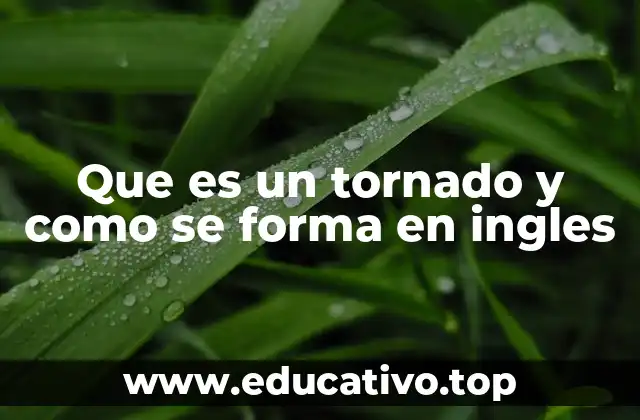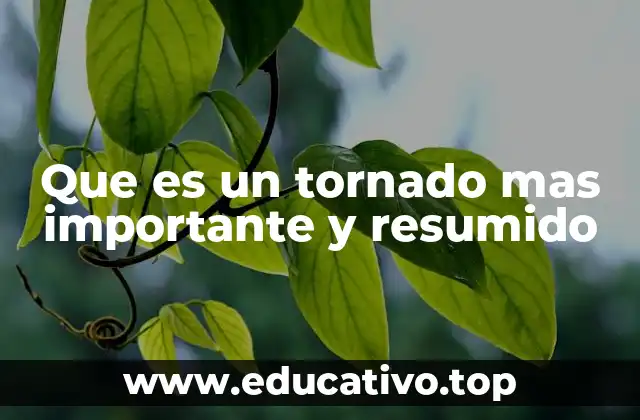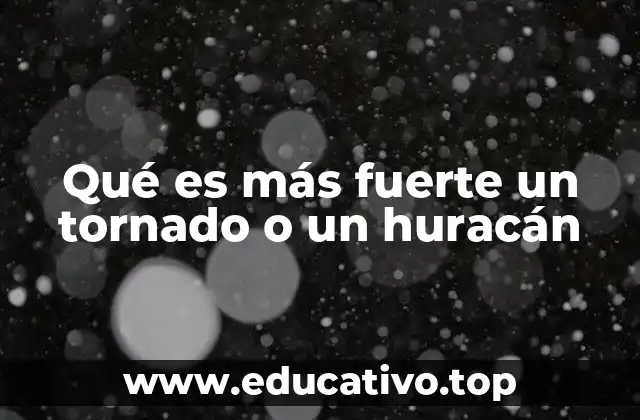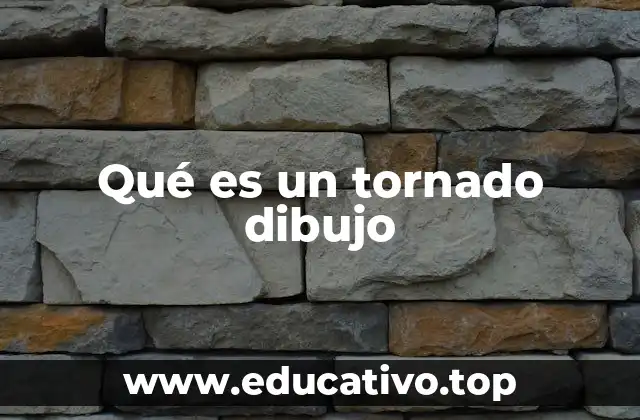Un tornado es uno de los fenómenos meteorológicos más violentos y fascinantes que puede ocurrir en la Tierra. En inglés, se conoce como tornado, y su formación está relacionada con condiciones climáticas extremas. Aprender sobre qué es un tornado y cómo se forma en inglés no solo ayuda a comprender mejor este fenómeno, sino que también es útil para personas interesadas en meteorología o en mejorar su conocimiento en idioma inglés. En este artículo, exploraremos a fondo este tema, incluyendo definiciones, causas, ejemplos y mucho más, todo en inglés, para facilitar su comprensión y uso lingüístico.
¿Qué es un tornado y cómo se forma?
A tornado is a violent rotating column of air that extends from a thunderstorm to the ground. It is one of the most dangerous and unpredictable weather phenomena on Earth. Tornadoes are often associated with supercell thunderstorms, which are characterized by a rotating updraft. The formation of a tornado involves a complex interplay of atmospheric conditions, including warm, moist air near the ground and cooler, drier air above.
The process of formation, known as tornado genesis, typically starts when warm, humid air rises and meets cooler air above, creating instability in the atmosphere. This leads to the development of a rotating column of air, which can intensify and descend to the ground as a tornado. The Fujita scale (or Enhanced Fujita scale) is used to classify tornado intensity based on wind speed and damage.
How Tornadoes Are Linked to Severe Weather Systems
Tornadoes are often the result of severe weather systems, particularly those involving supercell thunderstorms. These storms are highly organized and can last for several hours. The key to tornado formation lies in the presence of wind shear — a change in wind speed or direction with height — which causes the air to begin rotating horizontally. As rising air tilts this rotation into a vertical position, a mesocyclone forms within the storm, and if the conditions are right, this can evolve into a tornado.
It’s also important to note that while tornadoes can occur in many parts of the world, the United States experiences the highest frequency, especially in an area known as Tornado Alley. This region includes parts of Texas, Oklahoma, Kansas, and Nebraska, where the collision of warm, moist air from the Gulf of Mexico and cold, dry air from the Rockies creates ideal conditions for tornado development.
The Role of Meteorologists in Predicting Tornadoes
Meteorologists play a crucial role in predicting and tracking tornadoes. Using advanced radar systems, such as Doppler radar, they can detect rotation within thunderstorms and issue tornado warnings. These warnings are essential for public safety, as tornadoes can form quickly and without much warning. In the United States, the National Weather Service (NWS) issues tornado watches and warnings based on radar observations and storm reports.
In recent years, advancements in weather modeling and forecasting have improved the lead time for tornado warnings, which can range from a few minutes to an hour. However, predicting the exact location and intensity of a tornado remains a challenge, as tornadoes can develop rapidly and are influenced by a variety of atmospheric factors.
Examples of Tornadoes and Their Classification
To better understand what a tornado is, it helps to look at some real-life examples. One of the most famous tornadoes in history is the Tri-State Tornado of 1925, which traveled through parts of Missouri, Illinois, and Indiana. It is considered the deadliest tornado in U.S. history, killing over 600 people. Another notable example is the Joplin Tornado of 2011, which was an EF5 tornado (the highest rating on the Enhanced Fujita scale) and caused massive destruction in Missouri.
Tornadoes are classified using the Enhanced Fujita (EF) scale, which ranges from EF0 to EF5. Each category is based on the estimated wind speeds and the type of damage caused. For example, an EF0 tornado may only damage trees and roofs, while an EF5 tornado can completely destroy well-built structures.
The Science Behind Tornado Formation
The formation of a tornado is a complex meteorological process that involves several key scientific principles. The primary factors include wind shear, instability in the atmosphere, and moisture. Wind shear creates the rotation that can lead to a tornado, while instability allows warm, moist air to rise rapidly. This rising air forms updrafts that can enhance the storm’s intensity.
Another important factor is the Lifted Condensation Level (LCL), which determines how high the air must rise before clouds form. If the LCL is low, it means that the air is very moist, which can contribute to stronger storms. Additionally, the CAPE (Convective Available Potential Energy) value is used to measure the potential energy available for thunderstorm development.
A List of Key Terms Related to Tornadoes in English
Here is a list of essential terms related to tornadoes, all in English:
- Tornado – A rotating column of air extending from a thunderstorm to the ground.
- Supercell – A thunderstorm with a rotating updraft that can produce tornadoes.
- Mesocyclone – A large, rotating updraft within a supercell storm.
- Doppler Radar – A radar system used to detect motion and rotation in the atmosphere.
- Fujita Scale (EF Scale) – A rating system for tornado intensity based on damage.
- Tornado Watch – A warning that tornadoes are possible in a given area.
- Tornado Warning – A warning that a tornado has been sighted or detected by radar.
- Funnel Cloud – A rotating column of air that has not yet reached the ground.
- Hook Echo – A radar signature that indicates a possible tornado.
- Tornado Alley – A region in the U.S. where tornadoes are most frequent.
Understanding these terms is essential for anyone studying meteorology or interested in severe weather in English.
Understanding the Impact of Tornadoes on Communities
Tornadoes can have devastating effects on communities, causing significant damage to homes, infrastructure, and even loss of life. In areas like Tornado Alley, residents often live with the constant threat of these storms. Schools and communities conduct regular tornado drills to prepare for emergencies, and many homes are built with storm shelters or safe rooms to protect people during a tornado.
In addition to physical damage, tornadoes can also lead to long-term psychological effects on survivors. The unpredictability and intensity of tornadoes make them particularly terrifying, and recovery can take years in some cases. Communities often rely on government aid, insurance, and volunteer organizations to rebuild after a major tornado event.
¿Para qué sirve conocer qué es un tornado y cómo se forma?
Understanding what a tornado is and how it forms is essential for several reasons. First, it helps people recognize the signs of a developing tornado and take appropriate safety measures. For example, knowing that a funnel cloud has formed or that a tornado warning has been issued can save lives.
Additionally, this knowledge is valuable for students, educators, and researchers who are studying meteorology and severe weather patterns. It also plays a role in public policy and urban planning, as communities must design infrastructure that can withstand extreme weather events. In short, learning about tornadoes is not just an academic pursuit — it is a practical necessity for safety and preparedness.
Alternative Ways to Describe Tornadoes in English
Tornadoes can also be described using various synonyms or alternative expressions in English. Some of these include:
- Whirlwind – A general term for any rapidly rotating mass of air.
- Cyclone – A term used for large, rotating storm systems in different parts of the world.
- Spiral storm – A poetic or descriptive term for a tornado.
- Twister – A colloquial term often used in movies and media.
- Funnel storm – A less common term for a tornado.
While these terms can sometimes be used interchangeably, it’s important to note that not all of them refer specifically to tornadoes. For example, the term cyclone is often used in the context of tropical storms or hurricanes in the Indian Ocean or South Pacific regions.
The Connection Between Climate and Tornado Frequency
The frequency and intensity of tornadoes are closely linked to broader climate patterns. While tornadoes are not directly caused by climate change, scientists believe that changing climate conditions could influence the frequency and distribution of tornadoes in the future. For example, warmer temperatures can increase the amount of moisture in the atmosphere, which may lead to more intense thunderstorms and, potentially, more tornadoes.
However, the relationship between climate change and tornadoes is still an area of active research. Some studies suggest that tornado activity may become more erratic or shift to different regions due to changes in atmospheric circulation patterns. Understanding these connections is crucial for long-term weather forecasting and disaster preparedness.
The Meaning of a Tornado in English and Its Cultural Significance
In English, a tornado is more than just a meteorological term — it also holds cultural and symbolic meaning. In literature and film, tornadoes are often used as metaphors for chaos, destruction, or transformation. For example, the 1939 film *The Wizard of Oz* features a tornado that carries Dorothy to a magical land, symbolizing a journey of self-discovery.
In real life, tornadoes have shaped the history of many regions. The Great Plains of the United States, for example, have long been known for their frequent tornado activity, and this has influenced everything from architecture to emergency response strategies. Understanding the meaning of a tornado in English is therefore important not only for scientific purposes but also for cultural and historical contexts.
¿De dónde proviene la palabra tornado?
The word tornado has its origins in Spanish. It comes from the Spanish word *tronada*, which means thunderstorm. The term was first used in the 17th century to describe a violent windstorm. Over time, the word was adopted into English and came to specifically refer to the rotating wind column we now call a tornado.
The term *tornado* is also related to the Spanish word *tronar*, meaning to thunder or to rumble. This connection reflects the association between tornadoes and thunderstorms. While the exact etymology is debated, the Spanish influence on the word is clear, and it has become the standard term used in both scientific and colloquial contexts in English.
Other English Terms for Tornadoes and Related Phenomena
In addition to tornado, there are several related terms in English that are useful to know:
- Storm – A general term for a violent atmospheric disturbance.
- Thunderstorm – A storm accompanied by thunder, lightning, and often heavy rain.
- Supercell – A type of thunderstorm with a rotating updraft.
- Mesocyclone – A rotating column of air within a supercell.
- Dust Devil – A small whirlwind that forms over dry land.
- Water Spout – A tornado that forms over water.
While these terms describe different types of weather events, they are all connected to the broader category of severe weather. Understanding these terms can help in identifying and describing various atmospheric phenomena accurately.
What Causes Tornadoes to Form?
The formation of a tornado is the result of specific atmospheric conditions coming together. The main factors include:
- Warm, moist air near the ground – This provides the energy needed for storm development.
- Cold, dry air above – This creates instability in the atmosphere.
- Wind shear – A change in wind speed or direction with height, which causes air to begin rotating.
- Lifting mechanism – Such as a cold front or dry line, which forces the warm air to rise.
When these conditions are present, they can lead to the formation of a supercell thunderstorm. If the storm develops a mesocyclone, and if the rotation tightens and descends to the ground, a tornado may form. This process can happen quickly, which is why tornadoes are so difficult to predict with precision.
How to Use the Word Tornado in English and Examples of Usage
The word tornado is used in English in several contexts. Here are some common ways to use it:
- In news reports: A tornado was spotted near the town of Greensburg this afternoon.
- In scientific writing: The study analyzed the formation of tornadoes in the central United States.
- In everyday conversation: We had to take shelter during the tornado last night.
- In literature: The tornado swept through the valley, leaving nothing but destruction in its wake.
Here are some example sentences:
- Meteorologists issued a tornado warning for the region.
- The tornado destroyed over 100 homes in minutes.
- I’ve never seen a tornado in person, but I’ve heard they’re terrifying.
- The children were learning about tornadoes in science class.
Using the word correctly in context is essential for effective communication, especially when discussing weather or safety.
The Global Impact of Tornadoes
While tornadoes are most commonly associated with the United States, they can occur in many parts of the world. Countries such as Canada, Bangladesh, China, and Australia also experience tornadoes, though they are less frequent than in the U.S. In Bangladesh, for example, tornadoes are particularly deadly due to high population density and poor infrastructure.
Tornadoes have a significant global impact, not just in terms of destruction but also in terms of economic cost and loss of life. They affect agriculture, infrastructure, and communities worldwide, and their increasing frequency in some regions may be linked to climate change. Understanding how tornadoes form and how to respond to them is a global concern.
The Future of Tornado Research and Technology
The future of tornado research is promising, thanks to advancements in technology and data analysis. Scientists are using high-resolution radar, satellite imagery, and computer models to better understand tornado formation and behavior. Drones are being tested to study tornadoes from the air, and machine learning algorithms are being developed to predict tornado development with greater accuracy.
These innovations have the potential to improve early warning systems and save lives. As climate patterns continue to change, the need for advanced tornado research becomes even more critical. By investing in research and technology, we can better prepare for and respond to these powerful natural phenomena.
Jimena es una experta en el cuidado de plantas de interior. Ayuda a los lectores a seleccionar las plantas adecuadas para su espacio y luz, y proporciona consejos infalibles sobre riego, plagas y propagación.
INDICE








